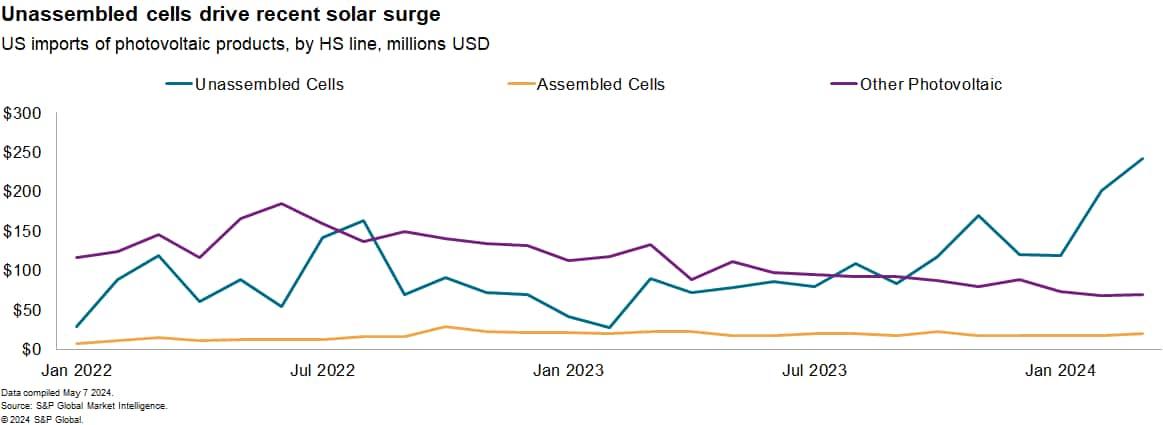Customer Logins
Obtain the data you need to make the most informed decisions by accessing our extensive portfolio of information, analytics, and expertise. Sign in to the product or service center of your choice.
Customer Logins
BLOG
Jun 07, 2024
The impact of solar power equipment tariffs on global supply chains
Learn more about our Supply Chain Console
The American Alliance for Solar Manufacturing Trade Committee (AASMTC) has filed a petition with the US International Trade Commission (US ITC) to impose anti-dumping and countervailing duties on solar panel imports from Cambodia, Vietnam, Malaysia and Thailand. The AASMTC claims that manufacturers from these countries are dumping products below cost in the US market and receiving subsidies.
The case illustrates the adaptive nature of supply chains and trade protections — buyers will look for cheaper sources after adjusting for tariffs. In turn that can force governments to continually shift and expand the focus of tariffs. Additional considerations like operational risk also factor in company decisions to move production.
The AASMTC petition
The US Commerce department had already found that imports from Cambodia, Vietnam, Malaysia and Thailand were circumventing anti-dumping and countervailing duties on mainland China in 2022 but delayed applying tariffs for two years. The delay placed on the implementation of those duties, which expires in June 2024, could increase tariff rates on imports from the four countries to as much as 280.18% from 14.25% currently. The delay was designed to support solar projects funded by the Inflation Reduction Act while keeping the cost of panels down. The Biden administration said that the exemption would end as scheduled on June 6, 2024.
The AASMTC petition claims that the delay gave "the Chinese-owned solar manufacturers in these countries time to shift their supply chains," which no longer qualify as circumvention and so require direct trade remedies to address.
Malicious circumvention and other trade injuries cannot be seen directly in published trade data. Rather, the US ITC and US Commerce Department use additional formulas and due diligence.
If additional duties are levied, other import sources may be the Netherlands, which made up 9.2% of global exports in 2023; Singapore, which made up 2.8% of the world export total; or India, which made up 2.1% of the total.
Sign up for our Supply Chain Essentials newsletter
Drivers of reshoring
In common with other industries, reshoring of sourcing is often driven by a wide array of cost and risk considerations beyond tariffs. In the case of labor costs, moving manufacturing can be advantageous. Labor costs in Vietnam, Thailand, Cambodia and Malaysia all offered cost advantages over mainland China, with Cambodia being the lowest from an hourly wage perspective, our data shows.
Operational risk controls are also important when looking to assure a steady flow of products. This is vital for solar panels where utility-scale projects rely on on-time delivery.
India could be a potential site to move manufacturing, both for geopolitical and cost reasons. The country has lower manufacturing wages than mainland China at the tradeoff of additional operational risk and is a significant market for goods itself.
New sources of US solar imports
Solar panel imports to the US increased by 78.2% year over year in 2023, though have slowed somewhat in the first quarter of 2024.
Growth was centered around unassembled modules, which made up 67.9% total photovoltaic imports in the first quarter. These unassembled modules saw imports increase by 252.7% year over year in the same period after increasing by 2.7% in 2023.
The growth of unassembled modules may indicate that assembly is growing in the US — this may allow companies to adapt to tariffs if unassembled modules from different countries are substitutable.
Imports of assembled modules fell by 12.4% and only made up 6.7% of photovoltaic imports by value while imports of other photovoltaic semiconductors fell by 41.9% year over year in the first quarter and accounted for 25.4% of imports.

Imports of solar panels from countries targeted in the new case have grown significantly faster than total imports. Shipments from Thailand increased by 152.8% year over year in 2023 and by a further 17.8% in the first quarter. There's also been a surge in imports from Malaysia and Vietnam. Cambodia, the other country named in the petition, has seen a turnaround as imports fell year over year in the first quarter after increasing by 209.5% in 2023.
Imports from the four countries combined represented 71.1% of total US imports in 2023, up from 60.6% in 2019. Imports from mainland China remained a minor part of US solar, making up 0.2% of imports by value in the first quarter of 2024 and in 2023 as a whole.
Company responses
Companies can react to potential tariffs in two ways: preemptively looking for new sources or stockpiling additional goods. Another strategy can be to shift the destination of goods to countries without duties. Our data shows that more than half of solar panel exports by value from Vietnam are to the US in the 12 months to Feb. 29. Other destinations like Singapore and India made up 13.5% and 5.6% of exports, respectively.
Even if new dumping and countervailing duties are enacted, companies that share information with the US ITC and US Commerce Department can end up paying significantly less than the punitive all country rates. Companies also have many options to offset the impact of higher tariffs, even aside from shifting sourcing. Those can include raising customer prices — particularly with utility customers that may have cost pass-through arrangements with their final customers — or negotiating lower prices with suppliers further up the supply chain.
As the solar power industry continues to evolve, it is essential for companies to remain agile and proactive in navigating the changing landscape of tariffs and trade policies.
Learn more about our data and insights
This article was published by S&P Global Market Intelligence and not by S&P Global Ratings, which is a separately managed division of S&P Global.
{"items" : [
{"name":"share","enabled":true,"desc":"<strong>Share</strong>","mobdesc":"Share","options":[ {"name":"facebook","url":"https://www.facebook.com/sharer.php?u=http%3a%2f%2fstage.www.spglobal.com%2fmarketintelligence%2fen%2fmi%2fresearch-analysis%2fimpact-of-solar-power-equipment-tariffs-on-global-supply-chains.html","enabled":true},{"name":"twitter","url":"https://twitter.com/intent/tweet?url=http%3a%2f%2fstage.www.spglobal.com%2fmarketintelligence%2fen%2fmi%2fresearch-analysis%2fimpact-of-solar-power-equipment-tariffs-on-global-supply-chains.html&text=The+impact+of+solar+power+equipment+tariffs+on+global+supply+chains+%7c+S%26P+Global+","enabled":true},{"name":"linkedin","url":"https://www.linkedin.com/sharing/share-offsite/?url=http%3a%2f%2fstage.www.spglobal.com%2fmarketintelligence%2fen%2fmi%2fresearch-analysis%2fimpact-of-solar-power-equipment-tariffs-on-global-supply-chains.html","enabled":true},{"name":"email","url":"?subject=The impact of solar power equipment tariffs on global supply chains | S&P Global &body=http%3a%2f%2fstage.www.spglobal.com%2fmarketintelligence%2fen%2fmi%2fresearch-analysis%2fimpact-of-solar-power-equipment-tariffs-on-global-supply-chains.html","enabled":true},{"name":"whatsapp","url":"https://api.whatsapp.com/send?text=The+impact+of+solar+power+equipment+tariffs+on+global+supply+chains+%7c+S%26P+Global+ http%3a%2f%2fstage.www.spglobal.com%2fmarketintelligence%2fen%2fmi%2fresearch-analysis%2fimpact-of-solar-power-equipment-tariffs-on-global-supply-chains.html","enabled":true}]}, {"name":"rtt","enabled":true,"mobdesc":"Top"}
]}






